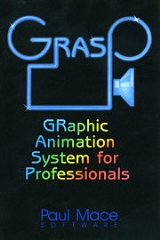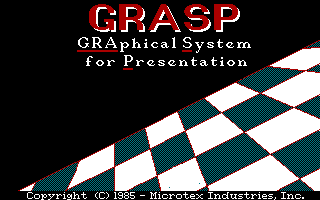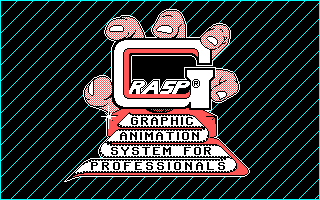
GRaphics Animation System for Professionals
Encyclopedia
GRASP - GRAphical System for Presentation
GRASP was the first multimedia animation program for the IBM PCIBM PC
The IBM Personal Computer, commonly known as the IBM PC, is the original version and progenitor of the IBM PC compatible hardware platform. It is IBM model number 5150, and was introduced on August 12, 1981...
"Family of
Computers". It was also at one time the most widely used animation format.
Originally conceived by Doug Wolfgram under the name FlashGun, the first public version of GRASP was the GRAphical System for Presentation. The original software was written by Doug Wolfgram and Rob Neville. It later became the GRaphic Animation System for
Professionals. Many regard this as the birth of the multimedia industry.


GRASP 1.0
In 1984 Doug Wolfgram conceived of the idea of an animation scripting language that would allow graphics images to move smoothly across a computer screen under program control. Persyst Systems hired Wolfgram's company to develop some graphics and animation for their new graphics card, the BoB board. The marketing manager from Persyst then moved to AST computer where he brought in Wolfgram to do similar animation work for the AST line of peripheral cards for PCs.Wolfgram saw the growing demand for multimedia so he brought in John Bridges
John Bridges (software developer)
John Bridges is the co-author of the software program PCPaint and primary developer of the program GRASP for Microtex Industries with Doug Wolfgram. He is also the sole author of GLPro and AfterGRASP. His article entitled "Differential Image Compression" was published in the February 1991 issue of...
, with whom he had co-developed PCPaint for Mouse Systems in 1982. Together they co-developed the early versions of GRASP for Wolfgram's company, Microtex Industries. Subsequent versions followed. Version 1.10c was
released in September 1986.
Starting with John and Doug's source code for PCPaint
PCPaint
PCPaint was the first IBM PC-based mouse driven GUI paint program . It was developed by John Bridges and Doug Wolfgram.The hardware manufacturer Mouse Systems bundled PCPaint with millions of computer mice that they sold, making PCPaint also the best-selling MS-DOS-based paint program of the late...
, the painting aspects were chopped out and
instead a simple font editor for Doug's slideshow program FlashGun was created. The graphics library was used to make a simple script playback that had a command for each graphics library function. It also originally used the assembly language
Assembly language
An assembly language is a low-level programming language for computers, microprocessors, microcontrollers, and other programmable devices. It implements a symbolic representation of the machine codes and other constants needed to program a given CPU architecture...
fades from FlashGun for
a "FADE" command, but those image fade routines were mode specific (CGA) and difficult to enhance. The routines were rewritten along with the script parts. It stored all the files in a ZIB archive, renaming John Bridges' program ZIB
to GLIB and the archives it produced were GL files (GRASP GL library format
GRASP GL library format
The GL library format is a self-contained animation library used by the GRASP GRaphical System for Presentation to store scripts, pictures, and all the commands needed for a GRASP animation....
).
GRASP 2.0
In 1987, GRASP 2.0, was released and no longer distributed as ShareWare. Itbecame a commercial product published in the USA by Paul Mace Software. John Bridges assumed responsibility for development of the core engine while Wolfgram developed fades, external utilities and new commands.
GRASP 3.0 and 3.5
In 1988, GRASP 3.0 was released, followed in October 1988 by GRASP 3.5,bundled with Pictor Paint
Pictor Paint
Pictor Paint was an improved version of PCPaint, the first IBM PC-based mouse driven GUI paint program. It was written by John Bridges, the primary author of PCPaint, and bundled with GRASP GRaphical System for Presentation also written by John Bridges...
, an improved PCPaint
PCPaint
PCPaint was the first IBM PC-based mouse driven GUI paint program . It was developed by John Bridges and Doug Wolfgram.The hardware manufacturer Mouse Systems bundled PCPaint with millions of computer mice that they sold, making PCPaint also the best-selling MS-DOS-based paint program of the late...
minus publishing features. GRASP 3.5 "[supported] a wide range of video formats, including CGA, EGA, Hercules, VGA and all popular enhanced VGA modes up to 800 x 600 pixels and 1,024 x 768 pixels resolution. The software [displayed] and [edited] images in several standard formats, including PC Paintbrush (PCX) and GIF."
Award-winning animator Tom Guthery claims that by using GRASP in 1990 his early animated computer programs "[gave] smooth movement and detailed animation to a degree that many programmers had thought impossible at the time".
GRASP 4.0
In February 1991 GRASP 4.0 was released, with the ability to create"self-executing" demos (bind to make EXE added), AutoDesk FLI/FLC support,
PC Speaker Digitized Sound, and a robust programming environment. It also included ARTOOLS, a collection of image manipulation tools which included an
early morphing utility which tracked all points in source and
destination images, creating all the in-between frames. Later that year HRFE (High Res Flic Enhancement) was offered as an add-on for GRASP, "[enabling] GRASP to recognize, import, manipulate and compile animations created in Autodesk's Animator Pro environment."
In a published paper critiquing GRASP 4.0, the authors Stuart White and John Lenarcic said that "The GRASP language offers creative freedom in the development of interactive multimedia presentations, especially to seasoned programmers with an artistic inclination."
A stripped-down version of GRASP 4.0 was also included with copies of Philip Shaddock's Multimedia Creations: Hands-On Workshop for Exploring Animation and Sound.
Multi-Media GRASP 1.0
In June 1993, Multi-Media GRASP 1.0 was released with TrueColor support.Authorship and Ownership
Early in 1990 Doug Wolfgram sold his remaining rights to GRASP (and PCPaint) to John Bridges.
In 1994, GRASP development stopped when John Bridges terminated his publishing contract with Paul Mace Software. In 1995, John created GLPro
GLPro
GLPro is a multimedia authoring application for MS-DOS and Microsoft Windows. GLPro is a contraction of Graphics Language Professional, and was written by John Bridges. GLPro was originally a MS-DOS program released in 1995, written as successor to GRASP, also written by Bridges and marketed by...
for IMS Communications Ltd, the newest incarnation of John's ideas behind GRASP updated for Windows
Microsoft Windows
Microsoft Windows is a series of operating systems produced by Microsoft.Microsoft introduced an operating environment named Windows on November 20, 1985 as an add-on to MS-DOS in response to the growing interest in graphical user interfaces . Microsoft Windows came to dominate the world's personal...
. In 2002, John Bridges created AfterGRASP, a successor to GRASP and GLPro.
Although some web pages list Paul Mace Software as "buying" GRASP or "owning" GRASP, that is not correct.
External links
- GRASP - GRaphical System for Presentation v1.10 Manual, released May 1986
- EONQUEST: An interactive multimedia learning environment for elementary mathematical problem solving by Stuart White and John Lenarcic
- "Doug and Melody Wolfgram", by Cynthia Gregory Wilson
- Pmace
- GLPro Mailing List Archive
- GRASP File Format Summary
- Encyclopedia of Graphics File Formats, 2nd Edition by Murray, James D. , Van Ryper, William ISBN 1-56592-161-5
- The formats of GRASP animation files By George Phillips
- The Graphics File Formats Page GL - Another animation format Dr. Martin Reddy Technical Lead, R & D, Pixar Animation Studios

